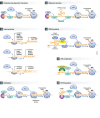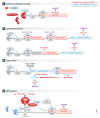Translation acrobatics: how cancer cells exploit alternate modes of translational initiation
- PMID: 30224410
- PMCID: PMC6172470
- DOI: 10.15252/embr.201845947
Translation acrobatics: how cancer cells exploit alternate modes of translational initiation
Abstract
Recent work has brought to light many different mechanisms of translation initiation that function in cells in parallel to canonical cap-dependent initiation. This has important implications for cancer. Canonical cap-dependent translation initiation is inhibited by many stresses such as hypoxia, nutrient limitation, proteotoxic stress, or genotoxic stress. Since cancer cells are often exposed to these stresses, they rely on alternate modes of translation initiation for protein synthesis and cell growth. Cancer mutations are now being identified in components of the translation machinery and in cis-regulatory elements of mRNAs, which both control translation of cancer-relevant genes. In this review, we provide an overview on the various modes of non-canonical translation initiation, such as leaky scanning, translation re-initiation, ribosome shunting, IRES-dependent translation, and m6A-dependent translation, and then discuss the influence of stress on these different modes of translation. Finally, we present examples of how these modes of translation are dysregulated in cancer cells, allowing them to grow, to proliferate, and to survive, thereby highlighting the importance of translational control in cancer.
Keywords: cancer; stress; translation initiation.
© 2018 The Authors.
Figures



References
-
- Hinnebusch AG (2014) The scanning mechanism of eukaryotic translation initiation. Annu Rev Biochem 83: 779–812 - PubMed
Publication types
MeSH terms
LinkOut - more resources
Full Text Sources
Other Literature Sources
Miscellaneous

